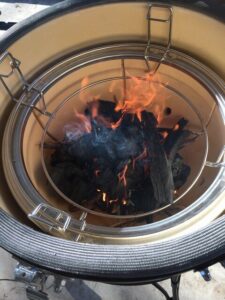How to stay food safe with your charcoal cooker Part 1 Storage

Woohoo – you’ve just got your new charcoal cooker or smoker. Yummy slow cooked and seared meats are on the menu. You may have some friends or family over to taste your charcoal cooking delights.
Outdoor cooking, especially in warm weather, can be an ideal place for bacteria to grow. We’ve got some pointers for you. This is the first part of our 3-part food safety series and it’s on safely storing the meats you plan to cook.
Buying and Storing Fresh Meat
- If you’re shopping at the supermarket, only buy meat with undamaged packaging, check that it’s sealed and no meat juices run out. Feel that the meat is still cold and check the use by date. It might look or smell ok after this date but it’s safer to eat it within the recommended time. Don’t buy anything that’s discoloured or smells off.
- Whether buying from the supermarket or a butcher, shop for your meat last and use an insulated shopping bag to keep it cold, especially in hot weather. If you need to travel for more than 30 minutes use an esky/insulated cooler to store your cold meat for the trip.
Storing Fresh Meat in the Fridge
- Using it that day, then raw meat can be stored in its plastic packaging in the fridge. Otherwise, it’s best placed on a non-plastic dish and covered with foil or loosely covered with plastic to allow a little air flow. Why? Because plastic will make meat sweat. Meat can be stored in plastic containers as long as there’s room for air flow around.
- Vacuum packed meat has a longer storage life in the fridge because all the air has been taken out of the bag. This delays any bacterial growth. It can develop a confinement smell which isn’t harmful and will disappear in a little while. This type of meat can be purple in colour because there’s no oxygen and will return to a normal colour after being removed from the packaging.
- Put raw meat on the bottom shelf or meat compartment of your fridge so it can’t drip onto any other foods.
- Don’t put raw and cooked meat together in the same compartment of the fridge. Cover food that is cooked or ready to eat.
- Make sure your fridge is 4-5°C or below.
Recommended Fridge Storage times:
Beef, veal, lamb, pork chops or steaks: 2-3 days
Beef, veal, lamb, pork roasts (boned and rolled): 2-3 days
Beef, veal, lamb, pork roasts (bone in): 3-4 days
Chicken and fish: 2-3 days
Vacuum packed meat (unopened): 4-6 weeks
Storing and Defrosting Frozen Meat
- Freeze meat in strong plastic or foil to protect it from freezer burn. Remove as much air as possible and tie off to keep the seal. Label with name, weight or amount and date of packaging.
- Frozen meat is best thawed in the fridge. It’s about 4-7 hours per 500g. This needs a little planning before you want to cook.
- If you’re short of time, frozen meat can be defrosted in the microwave. Care must be taken as the outside of the meat can get to a higher temperature so the defrosted meat must be cooked immediately rather than left to sit.
- Freezing meat does not kill any bacteria, it just slows its growth. Heat kills bacteria. So, it’s best not to refreeze defrosted meat unless it’s been cooked first. Also, the quality of the meat suffers every time it’s frozen, defrosted and frozen again. Freezing makes ice crystals within the meat that cracks the meat fibre and makes the meat bleed when defrosted. If this is repeated, the meat will be very dry. Plus, there’s an increased risk of microbial growth with it not being cooked first.
- If meat is frozen longer than its recommended storage time it starts to dry out. Its quality is affected as it’s drier but it’s safe to eat.
- Make sure your freezer is -18°C or below.
Recommended Freezer Storage times (raw meat that has been correctly stored)
Beef roast: 4-6 months
Beef steaks: 3-4 months
Lamb roast (whole): 4-6 months
Lamb chops: 2-3 months
Pork roast: 4-5 months
Pork chops: 3-4 months
Vacuum packed meat (unopened): 4-6 months.
The next part of this 3-part series is on Preparation and Part 3 is Cooking.